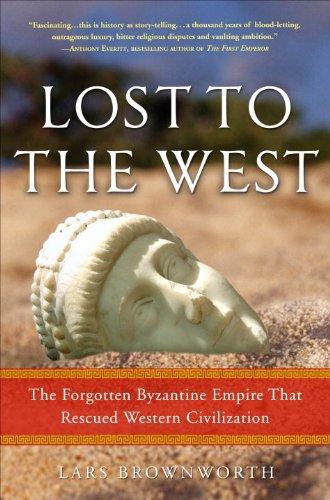
Lost to the West
The Forgotten Byzantine Empire That Rescued Western Civilization
کتاب های مرتبط
- اطلاعات
- نقد و بررسی
- دیدگاه کاربران
نقد و بررسی

July 13, 2009
The once common idea that the lights went out on classical and Western civilization when Rome fell in 476 C.E. has long since been debunked, but Brownsworth weighs in to illustrate that the Roman Empire's center of power simply shifted to Constantinople. In a narrative by turns spellbinding and prosaic, Brownsworth marches us through centuries of history, beginning long before the fall of Rome, and introduces the successive rulers of Byzantium, from Christian emperors to Muslim sultans, detailing a culture he describes as both familiar and exotic. He follows religious, political and cultural change up through the Islamic conquest of 1453. Christian refugees fled Byzantium into Europe, taking with them their longstanding love of ancient culture and introducing Western Europe to Plato, Demosthenes, Xenophon, Aeschylus and Homer, fanning the flames of the renaissance of Hellenistic culture that had already begun in various parts of Europe. Although Brownsworth admirably illustrates the ways that the Byzantine Empire lives on even today, Judith Herrin's Byzantium: The Surprising Life of a Medieval Empire
offers a more compelling and thorough history of this empire. Maps.

June 15, 2009
A history lecturer illuminates the fractious, little-studied period between the fall of the Roman Empire in the West and rise of the Ottomans in the 15th century.
With the breakup of the Roman Empire by Diocletian in the third-century CE into West and East, largely along linguistic lines, two distinct identities were forged over the succeeding centuries and grew increasingly estranged from and antagonistic to each other: Latin vs. Greek and Catholic vs. Orthodox. Brownworth examines the long-maligned Eastern half of the Empire, which saw its capital of Nova Roma chosen by Constantine the Great in 328 CE become the glorious, inimitable city of Constantinople. The author reminds us that the denizens of the East always referred to themselves as Roman, and the term Byzantium was later applied by Enlightenment scholars. Brownworth traces the highlights over the next 1,000 years of violent upheaval and murderous dynastic succession: e.g., early doomed attempts by Julian to repaganize the empire; fighting back the assaults by the barbarians and the sacking of Rome; the golden age under Justinian, who established Roman Law and reconquered numerous lost lands; and meeting the Islamic challenge from the seventh-century onward with holy wars and crusades until the ultimate devastation of Constantinople by the Turks in 1453. While the East held many of the ancient secular texts safe from the so-called Dark Ages that stymied the West, the author concentrates mostly on military, rather than cultural, events. Brownworth delivers just enough of the big picture for interested readers to pursue specific events in greater detail.
An energetic look at a still-misunderstood period in late antiquity.
(COPYRIGHT (2009) KIRKUS REVIEWS/NIELSEN BUSINESS MEDIA, INC. ALL RIGHTS RESERVED.)

October 1, 2009
"Lost" and "forgotten" are surely strange words for an empire that is well noted for its preservation of ancient cultures. This is that kind of thumping, old-fashioned popular history that could have been written a hundred years ago. Brownworth, a former high school history teacher, traces the Byzantine Empire from its founding by Constantine in 328 C.E. to its conquest by the Ottoman Turks in 1453. He is fond of semilegendary stories of treacherous dynasts and valiant generals (from Belisarius to last emperor Constantine XI) and doesn't like more modern perspectives, such as exploring sources and economics and everyday culturealthough there is some discussion of religious conflicts. Most significantly, he largely ignores the magnificent Byzantine artistic tradition. VERDICT Adrian Goldsworthy's recent "How Rome Fell" is a much more successful work in this genre that treats the early years of Byzantium. This book will provide an undemanding general reader new to the subject with a first glimpse of the Byzantine Empire.Stewart Desmond, New York
Copyright 2009 Library Journal, LLC Used with permission.

Starred review from August 1, 2009
In his compelling account of the Byzantine Empire, Brownworth unfolds the astonishing story of how the glory of Rome survived in ConstantinopleNew Rome for its proud residentsalmost a millennium after the collapse of Rome itself. Readers learn how Diocletian and Constantine transferred much of the Empires power to the great new city on the Bosporus long before the old capital fell, and they see how the transplanted flame of Roman culture burned brightly under the protection of a long line of Byzantine emperors. Despite intermittent misrule (such as that of Michael the Drunkard), the neo-Roman lineage of the East included emperors remarkable for legal wisdom (Justinian), political acumen (Leo VI), and military genius (Heraclius). Even Byzantine rulers notable for their brutal treachery (such as John Tzimisces) provide riveting episodes in the survival of an empire that long shielded the vulnerable West against Islamic armies while also preserving the literary treasures of classical Rome and Greece. Readers come to care deeply about the brave Byzantines who perish in 1453 making a heroic last stand against impossible odds.(Reprinted with permission of Booklist, copyright 2009, American Library Association.)

























دیدگاه کاربران